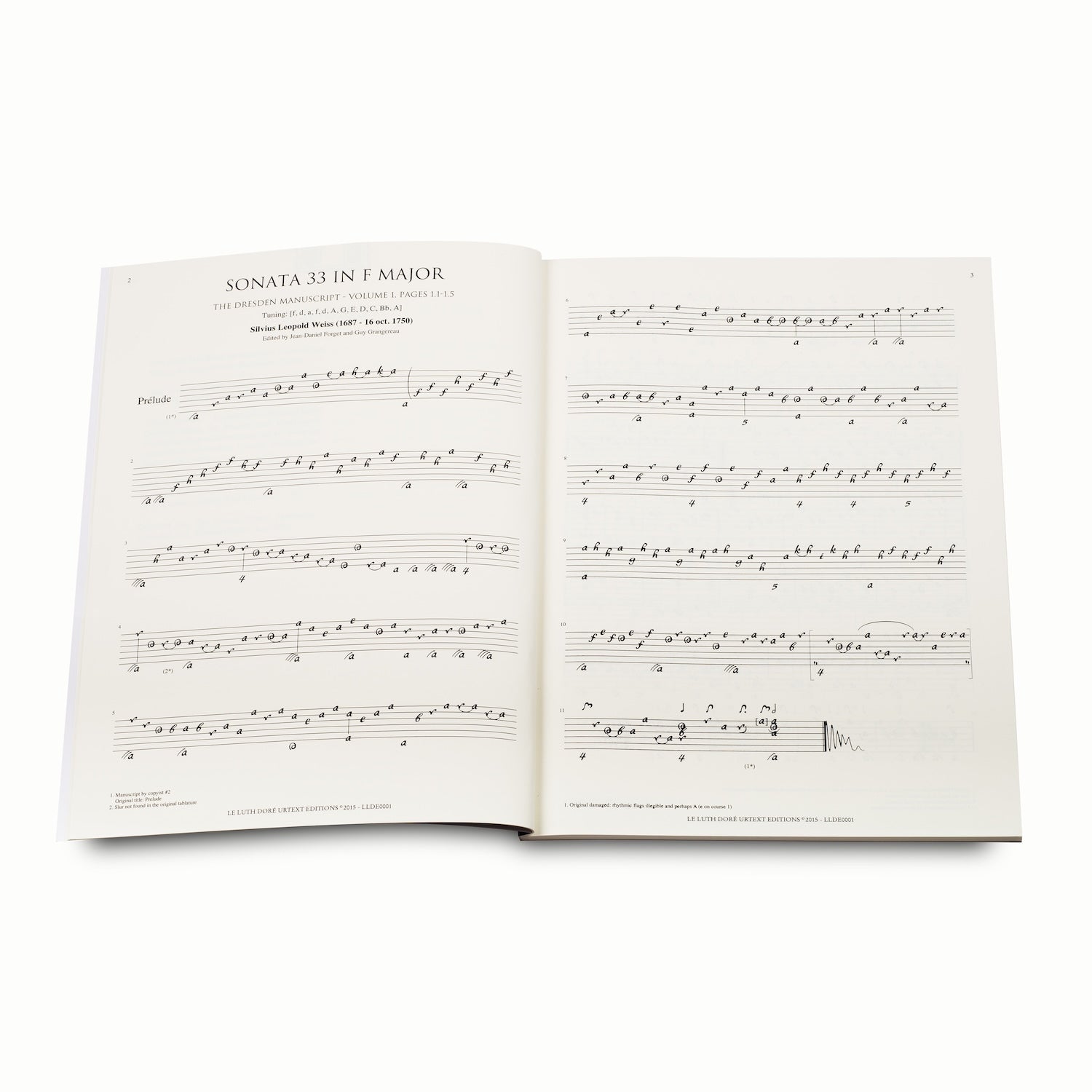My Store
The Dresden Manuscript, Lute Sonatas | Volumes I–V
The Dresden Manuscript, Lute Sonatas | Volumes I–V
SKU:LLDE0001-5
• Title: The Dresden Manuscript
• Subtitle: Lute Sonatas
• Date of Composition: c.1700–1750
• Source: Dresden Ms. D-Dl Mus. 2841-V-1
• Volumes: I to V
• Scholarly edition based on original sources
• Accurate transcriptions, historical fingering, optimal readability
• Ideal for concerts, research, or higher education
No VAT applied (Article 293 B of the French Tax Code).
Couldn't load pickup availability
Partager












The Zenith of the Baroque Lute at the Dresden Court
The five volumes of the Dresden Manuscript contain thirty-four sonatas by Silvius Leopold Weiss, carefully copied and organized by key.
A valuable testament to the art of lute playing in the eighteenth century, this corpus reflects the dense, expressive, and virtuosic writing of the German master.
This edition was prepared by Jean-Daniel Forget and Guy Grangereau, based on the original manuscripts held at the Sächsische Landesbibliothek in Dresden.
Product Details
Overview
The Dresden Manuscript & Silvius Leopold Weiss
The six volumes of French tablature from the Dresden Manuscript, preserved at the Sächsische Landesbibliothek, contain 34 sonatas by Silvius Leopold Weiss (1687–1750). Meticulously copied and organized by key, these works reflect the evolution of the baroque lute.
Acquired in 1929, the manuscripts were partially damaged in 1945. Weiss, a virtuoso and prolific composer, was closely associated with the greatest musicians of his time, including J. S. Bach. He contributed to the development of the lute by adding a thirteenth course and extending the neck.
Appointed to the Dresden court in 1718, he remained there until his death in 1750, leaving behind a monumental body of work devoted entirely to the lute.
Editors
Jean-Daniel Forget – IT specialist, lutenist
Passionate about the Baroque repertoire, Jean-Daniel Forget is a self-taught lutenist who has been transcribing and sharing early manuscripts for nearly twenty years. A professional IT specialist, he is proficient in music notation software adapted for tablature. In collaboration with Guy Grangereau, he publishes tablatures on a dedicated website. He has also assisted Miguel Serdoura in preparing his editions and his Méthode de Luth Baroque.
Guy Grangereau – Guitarist, lutenist
A professional musician, Guy Grangereau studied guitar in Paris with Turibio Santos before continuing his training at the Martenot School. After teaching for twenty years, he now performs on a 16-string hybrid instrument and a theorboed baroque lute. Since 2010, he has been working with Jean-Daniel Forget to transcribe and revise baroque manuscripts, notably those of Silvius Leopold Weiss.
Urtext Editions
Le Luth Doré Urtext Editions
Le Luth Doré Urtext Editions offer scores faithful to historical sources, optimized for musicians and musicologists. Our editions combine careful engraving, practical layout, durable materials, and a detailed critical apparatus in multiple languages.
Each text is rigorously established note by note to ensure an authentic restitution of the works, including original fingerings and ornamentations, as well as relevant stylistic suggestions.
Prepared by experts, our editions provide clear readability and informed interpretation of the early music repertoire.
We dedicate Le Luth Doré Urtext Editions to the memory of William H. Roberts († 2024), cofounder and source of inspiration for this collection. Without his vision and unwavering support, these editions would never have come into being.
Technical Details
• Editor(s): Jean-Daniel Forget & Guy Grangereau
• Musical period: Baroque
• Instrument(s): 11c/13c Baroque lute
• Instrumentation: Solo Baroque lute
• Notation: French tablature
• Modern edition: Urtext
• Publisher: Le Luth Doré Urtext Editions
• Year of publication: 2015
• Series: Lute and Theorbo Music Collection
• Dimensions: 230 × 310 mm
• Weight: 1.6 kg (set of 5 volumes)
• Binding: Sewn perfect binding
• Cover: Soft cover with flaps, anti-scratch lamination, gold stamping, and spot varnish
• Volumes I–V:
104 pp. (Vol. I) – ISMN 377-0-0017-8801-2
134 pp. (Vol. II) – ISMN 377-0-0017-8802-9
120 pp. (Vol. III) – ISMN 377-0-0017-8803-6
116 pp. (Vol. IV) – ISMN 377-0-0017-8804-3
68 pp. (Vol. V) – ISMN 377-0-0017-8805-0
Table of Contents
Sonata 33 in F Major • Sonata 32 in F Major • Sonata 1 in F Major
Sonata 28 in F Major • Sonata 34 in D minor • Sonata 11 in D minor
Sonata 35 in D minor • Sonata 36 in D minor • Sonata 37 in C Major
Sonata 38 in C Major • Sonata 39 in C Major • Sonata 40 in C Major
Sonata 41 in A minor • Sonata 42 in A minor • Sonata 29 in A minor
Sonata 43 in A minor • Sonata 12 in A Major • Sonata 44 in A Major
Sonata 16 in A Major • Sonata 45 in A Major • Sonata 46 in A Major
Sonata 47 in A Major • Sonata 48 in F-sharp minor • Sonata 4 in B-flat Major
Sonata 49 in B-flat Major • Sonata 15/23 in B-flat Major • Sonata 50 in B-flat Major
Sonata 21 in F minor • Sonata 25 in G minor • Sonata 51 in G minor
Sonata 7 in C minor • Sonata 27 in C minor • Sonata 52 in C minor
Sonata 30 in E-flat Major
Press Reviews

Editions for Baroque Lute
Each volume is crafted as a work of editorial art: high-quality printing, notation faithful to original sources, dual tablature (French and Italian), and rigorous critical apparatus.
Designed for today’s lutenists, these urtext editions embody the precision and elegance inherent to the art of the lute.











